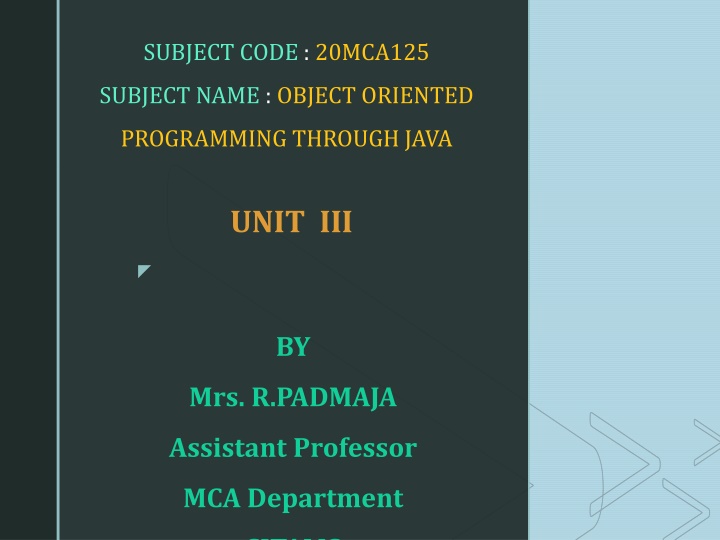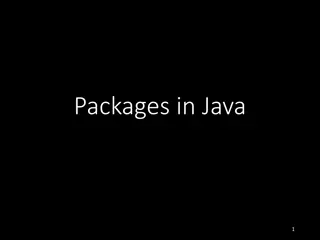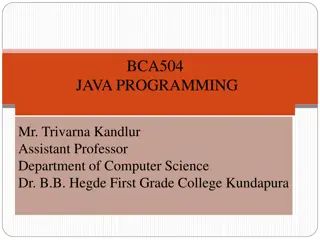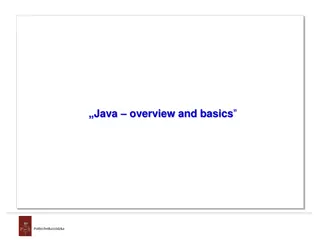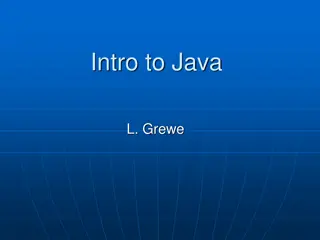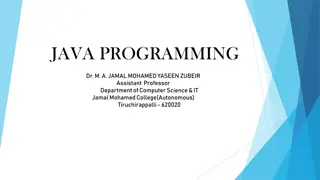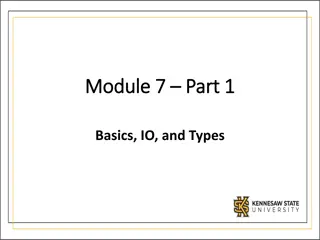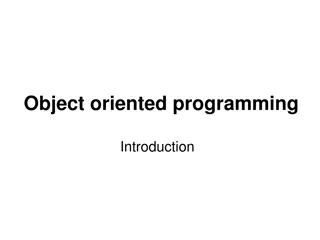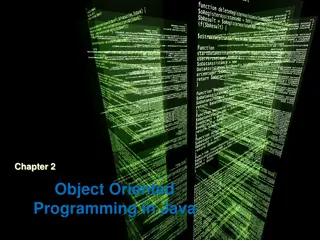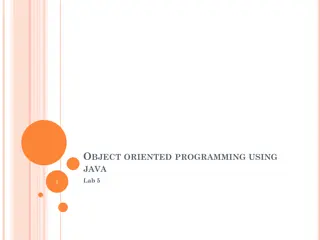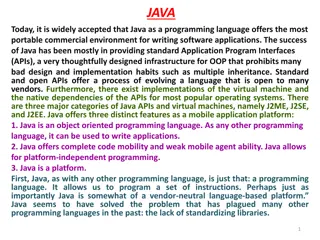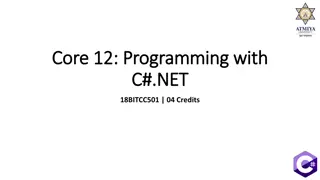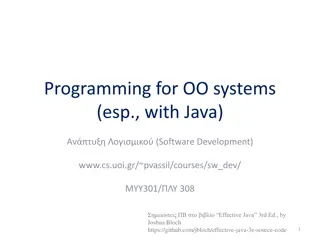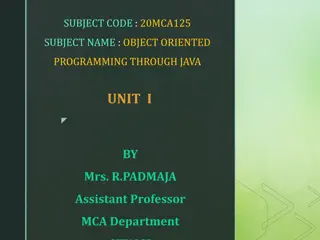Object-Oriented Programming Through Java: Unit III Collection Framework
This unit covers Collection Framework, Utility Classes, Interfaces, and more. Learn about defining and implementing interfaces in Java, accessing collections via iterators, and the characteristics of interfaces. Understand the syntax for defining interfaces and how they differ from classes.
Download Presentation

Please find below an Image/Link to download the presentation.
The content on the website is provided AS IS for your information and personal use only. It may not be sold, licensed, or shared on other websites without obtaining consent from the author.If you encounter any issues during the download, it is possible that the publisher has removed the file from their server.
You are allowed to download the files provided on this website for personal or commercial use, subject to the condition that they are used lawfully. All files are the property of their respective owners.
The content on the website is provided AS IS for your information and personal use only. It may not be sold, licensed, or shared on other websites without obtaining consent from the author.
E N D
Presentation Transcript
SUBJECT CODE : 20MCA125 SUBJECT NAME : OBJECT ORIENTED PROGRAMMING THROUGH JAVA UNIT III BY Mrs. R.PADMAJA Assistant Professor MCA Department SITAMS
UNIT III 2.Collection Framework 3.Utility Classes 1.Interfaces 2.1 Collection Overview 3.1 StringTokenizer 1.1 Defining an Interface 2.2 The Collection Interfaces 3.2 Scanner 1.2 Implementing Interfaces 2.3 The Collection Classes 1.3 Interfaces can be extended 2.4 Accessing a Collection via an Iterator
1.1 Defining an Interface An Interface is basically a kind of class An Interface is basically a kind of class 1.1 Defining an Interface Like classes, interface contain methods and variables but with a major Like classes, interface contain methods and variables but with a major difference. difference. The The difference difference is is that The The difference difference is is that that interfaces interfaces define that interfaces interfaces define define only define only only only Abstract Abstract Method Abstract Abstract Method Method & & Method & & Final Final and Final Final and and Static Static Variables and Static Static Variables Variables Variables i.e e methods methods are declared without any body and i.e e methods methods are declared without any body and and variables variables are implicitly final and variables variables are implicitly final and static, meaning they cannot be changed by the implementing class. and static, meaning they cannot be changed by the implementing class. They must also be initialized. They must also be initialized. All Methods Methods and Variables All Methods Methods and Variables Variables in the interface are implicitly public Variables in the interface are implicitly public public. . public. .
The syntax for defining an interface is very similar to that of defining a class The syntax for defining an interface is very similar to that of defining a class Interface Interface InterfaceName InterfaceName { { static and final Variables static and final Variables Abstract Methods Abstract Methods } } Where Interface variable Interface is the keyword and InterfaceName InterfaceName is any valid java Example: Example: Interface Item Interface Item { { } } static final static final int static final String name = Fan ; static final String name = Fan ; void display(); void display(); int code = 1001; code = 1001;
1 1. .2 2 Implementing Implementing Interface Interface An Interface will have 0 or more abstract methods which are all public public and and abstract abstract by by default default. . An Interface can have variables which which are are public, public, static static and and final final by by default, default, means means all all the the variables variables of of the the interface interface are are constants constants. Objects cannot be created to an interface whereas reference can be created. Once Once interface interface is is defined, defined, any any number number of of classes classes can can implement implement an an interface interface. . Also Also one one class class can can implement implement any any number number of of interfaces interfaces. . To Implement an interface, a class must create the complete set of methods defined by the interface.
To implement an interface, include the implements implements clause clause in a class definition, and then create the methods defined by the interface. General form of a class that includes the implements clause looks like Class Class ClassName ClassName [extends [extends SuperClass Interface Interface N]] N]] { { // // class class body body } } Example Example Class Class A A Extends Extends B B Implements Implements I I1 1,I ,I2 2 { { } } SuperClass] ] [implements [implements Interface Interface1 1[, [,... ... i.e if a class implements more than one interface, the interfaces are separated with a comma.
Interface Bank { } Class SBI implements Bank { public float reateOfInterest() { return (7.8f); } } class ICICI implements Bank { public float reateOfInterest() { return (9.8f); } } float rateOfInterest();
class IB implements Bank { public float reateOfInterest() { return (8.8f); } } class InterfaceDemo { public staticvoid main(String args[]) { SBI obj1 = new SBI(); float sbi_roi = obj1.rateOfInterest(); ICICI obj1 = new ICICI(); float icici_roi = obj1.rateOfInterest(); IB obj1 = new IB(); float ib_roi = obj1.rateOfInterest(); System.out.println( SBI rate of Interest is + sbi_roi); System.out.println( ICICI rate of Interest is + sbi_icici); System.out.println( IB rate of Interest is + sbi_ib); } }
Interface helps to Achieve the functionality of Multiple Inheritance Example interface I1 { void mi(); } interface I2 { void m2(); } Class A implements I1, I2 { void m1() { System.out.println( Method 1 is invoked ); } void m2() { System.out.println( Method2 is invoked ); } }
Class MutipleInheritanceDemo { public static void main(String args[]) { A obj1 = new A(); obj1.m1(); obj1.m2()); } }
1 1. .3 3 Interfaces Interfaces can can be be Extended Extended Like classes, interface can also be extended. i.e an interface can be sub interfaced from other interfaces. The new sub interface will inherit all the members of the super interface in the manner similar to subclasses. This is achieved using the keyword extends . General form of extending interfaces is Interface Interface NameNew NameNew extends extends name name1 1[, [, nameN nameN] ] { { Body Body of of Interface Interface } }
interface A { } interface B extends A { } Class MyClass implements B { void meth1(); void meth2(); void meth3(); public void meth1() { } public void meth2() { } public void meth3() { } System.out.println( implementing meth1() .. ); System.out.println( Implementing meth2() . ); System.out.println( Implementing meth3() . ); } Class InterfaceDemo { } Public static void main(string args[]) { MyClass obj = new MyClass(); obj.meth1(); obj.meth2(); obj.meth3(); }
When a class implements an interface that inherits another interface, it must provide implementations for all methods defined within the interface inheritance chain. Note Note : : if if a a class class that that implements implements an an interface give give implementations implementations to to all all the the methods methods of of the class class becomes becomes an an abstract abstract class class and and cannot cannot be interface and and the the interface, interface, then be instantiated instantiated. . the class class does does not then the not the
Interface Area { } Class Square implements Area { public float compute(float x) { } } Class Circle implements Area { public float compute(float x) { } } Class InterfaceDemo { Public static void main(String args[]) { } } final static float PI = 3.145; float compute(float x); return (x*x); return (PI*x*x); Square s = new Square(); double asqr = s.compute(10); Circle c = new Circle(); double acir = c.compute(10); System.out.println( Area of Square: +asqr); System.out.println( Area of Circle: +acir);
2. COLLECTION FRAMEWORK 2. COLLECTION FRAMEWORK 2.1 Collection Overview 2.2 The Collection Interfaces 2.3 The Collection Classes 2.4 Accessing a Collection via an Iterator 2.1 Collection Overview 2.1 Collection Overview Array is used to store a group of elements. Array is also used to store a group of Objects. But we cannot store different class objects in an array Java Soft people introduces Classes such as stack, vector, LinkedList, ArrayList etc.. which can store different Objects.sucjh classes are called Collection Clasess. A A Group Group of of collection collection classes classes is is called called a a Collection Collection Framework Framework
2. 2.
2.2 2.2 The Collection Interfaces The Collection Interfaces Collection Collection framework framework defines several interfaces. 2 2. .2 2. .1 1) ) The The List List Interface Interface: : List Interface is the subinterface of Collection. It guarantees the Order of Elements It Allows Duplicate Elements LinkedList, ArrayList, Vector are the implementation classses of List Interface Stack is a Subclass of Vector Some of the methods of List Interface are
Method Method Description Description void add(int index, E element) It is used to insert the specified element at the specified position in a list. boolean add(E e) It is used to append the specified element at the end of a list. void clear() It is used to remove all of the elements from this list. boolean equals(Object o) It is used to compare the specified object with the elements of a list. E get(int index) It is used to fetch the element from the particular position of the list. boolean isEmpty() It returns true if the list is empty, otherwise false. int lastIndexOf(Object o) It is used to return the index in this list of the last occurrence of the specified element, or -1 if the list does not contain this element.
2 2. .2 2. .2 2) ) The The Set Set Interface Interface: : Set Set is an interface interface which extends Collection. It is an unordered collection of objects List does not allow duplicate values Basically, Set Set is implemented by HashSet, LinkedHashSet or TreeSet (sorted representation). Set Interface declaration public public interface interface Set<E> extends extends Collection<E> Set Set has various methods methods to add, remove clear, size, etc to enhance the usage of this interface interface.
Method Method Description Description add( add( ) ) Adds an object to the collection. clear( clear( ) ) Removes all objects from the collection. contains( contains( ) ) Returns true if a specified object is an element within the collection. isEmpty isEmpty( ( ) ) Returns true if the collection has no elements. iterator iterator( ( ) ) Returns an Iterator object for the collection, which may be used to retrieve an object. remove( remove( ) ) Removes a specified object from the collection. size( size( ) ) Returns the number of elements in the collection.
2.3 2.3 The Collection Classes The Collection Classes Some of the collection classes provide full implementations that can be used as - is. Others are abstract, providing skeletal implementations that are used as starting points for creating concrete collections. The standard collection classes are summarised in the following table. CLASS CLASS DESCRIPTION DESCRIPTION HashSet HashSet Extends AbstractSet for use with the Hash table. LinkedHashSet LinkedHashSet Extends Hashset to allow insertion order itereations. LinkedList LinkedList Implements a LinkedList by extending AbstractSequentialList ArrayList ArrayList Implements a dynamic array by extending AbstractList. Stack Stack Implements List interface Vector Vector Implement List Interface
1. 1. ArrayList ArrayList Class Class An ArrayList is like an array, which can grow in memory dynamically. It means that when we stored elements into the ArrayList, depending on the number of elements, the memory is dynamically allotted and re-allotted to accommodate all the elements. ArrayList is not synchronized. This means that when more than one thread acts simultaneously on the ArrayList object, the results may incorrect in some cases. ArrayList can be written as class ArrayList<E> For Example, to store String type elements, we can create an objects to ArrayList as: ArrayList ArrayList<String> <String>arl arl = new = new ArrayList ArrayList<String>(); <String>();
ArrayList class includes the following methods: METHOD METHOD DESCRIPTION DESCRIPTION void add( void add(intposition intposition, element obj obj) ) , element This method inserts the specified elements at the specified position in the ArrayList element remove( element remove(int int position) position) This method removes an element at the specified position in array list. boolean remove (Object boolean remove (Object obj obj) ) This method removes the first occurrence of the specified element obj from the ArrayList, if it present void clear() void clear() This method removes all the elements from the ArrayList. set set(int position, element obj) (int position, element obj) This method replaces an element at the specified position in the ArrayList with the specified element obj boolean contains(Object boolean contains(Object obj obj) ) This method returns the element available at the specified position in the ArrayList. element get( element get(int int position) position) this method returns the element available at the specified position in the ArrayList. Int Int indexOf indexOf(Object (Object obj obj) ) method returns the position of the first occurrence of the specified element obj in the list, or -1 if the element is bot found in the list. intlastIndexOf intlastIndexOf(Object (Object obj obj) ) This method returns the position of the last occurrence of the specified element obj in the list, or -1 if the element is bot found in the list. int int size(): size(): This method returns the number of elements present in the ArrayList.
Program: Program: import java.util.*; Class ArraylistDemo { } public static void main(String args[]) { ArrayList<String>arl=new ArrayList<String(); arl.add("JAVA"); arl.add("CN"); arl.add("OS"); arl.add("PSQT"); arl.add("AFM"); System.out.println("Element in ArrayList are" +arl); //remove two objects arl.remove(3); boolean b=arl.remove("JAVA"); //display again System.out.println("Element in Array list after removing are +arl); Iterator it =arl.iterator(); while(it.hasNext()) { String s=(String)it.next(); System.out.println(s); } }
OUTPUT: OUTPUT: Element in Element in ArrayList Element in Array list after removing are [CN, OS, AFM] Element in Array list after removing are [CN, OS, AFM] CN CN OS OS AFM AFM ArrayList are[JAVA, CN, OS, PSQT, AFM] are[JAVA, CN, OS, PSQT, AFM]
2) 2) LinkedList LinkedList Class A Linked list contains a group of elements in the form of nodes. Class Each node will have three fields- the data field contains data and the link fields contain references to previous and next nodes. Linked list is very convenient to store data. Inserting the elements into the linked list and removing the elements from the linked list is done quickly and takes the same amount of time. A linked list is written in the form of class class LinkedList LinkedList<E> <E> For Example, to store String type elements, we can create an objects to LinkedList as: LinkedList LinkedList<String> <String>ll ll = new = new LinkedList LinkedList<String>(); <String>();
LinkedList class includes the following methods METHOD METHOD DESCRIPTION DESCRIPTION boolean add(element boolean add(element obj obj) ) This method add an element to the linked list. It returns true if the element is added successfully void add( void add(int element element obj int position, position, obj) ) This method inserts the specified elements at the specified position in the linked List. void void addFirst addFirst(element (element obj obj) ) This method adds the element obj at the first position of the linked list. void void addLast addLast(element (element obj obj) ) This method appends the specified element to the end of the linked list. Element Element removeFirst removeFirst() () This method removes the first element from the linked list and returns it. element element removeLast removeLast() () This method removes the last element from the linked list and returns. element remove( element remove(int position) position) int This method removes an element at the specified position in the linked list. void clear() void clear() This method removes all the elements from the linked list.
LinkedList class includes the following methods METHOD METHOD DESCRIPTION DESCRIPTION element get( element get(int int position) position) This method returns the element at the specified position in the linked list element element getFirst getFirst() () This method returns the first element from the list. Element Element getLast getLast() () This method returns the last element from the list int int indexOf indexOf(Object (Object obj obj) ) This method returns the position of the first occurrence of the specified element obj in the list, or -1 if the element is not found in the list intlastIndexOf intlastIndexOf(Object (Object obj obj) ) This method returns the position of the last occurrence of the specified element obj in the list, or -1 if the element is not found in the list. int int size() size() This method returns the number of elements present in the linked List.
Program: Program: //Demonstrate //Demonstrate Linkedlist import import java.util java.util.*; class class LLDemo LLDemo { { public static void main(String public static void main(String args { { } } } } OUTPUT: OUTPUT: LinkedList LinkedList Elements are: Elements are: Java Java Computer Network Computer Network Operating System Operating System Accounts Accounts Statistics Statistics Linkedlist class .*; class args[]) []) LinkedList LinkedList<String> ll.add ll.add("Java"); ("Java"); ll.add ll.add("Computer Network"); ("Computer Network"); ll.add ll.add("Operating System"); ("Operating System"); ll.add ll.add("Accounts"); ("Accounts"); ll.add ll.add("Statistics"); ("Statistics"); System.out.println System.out.println(" ("LinkedList for(String i:ll); for(String i:ll); { { System.out.println System.out.println( (i i); ); } } <String>ll ll= new = new LinkedList LinkedList<String>(); <String>(); LinkedList elements are:"); elements are:");
3 3) ) HashSet HashSet Class A HashSet represents a set of elements (objects). Class It does not guarantee the order of elements. Also it does not allow the duplicate elements to be stored. .A HashSet is written in the form of class class HashSet HashSet<E> <E> For Example, to store String type elements, we can create an objects toHashSetas: HashSet HashSet<String> <String>hs hs= = new new HashSet HashSet<String>() <String>(); ; HashSet HashSet class class includes includes the the following following methods methods. .
METHOD METHOD DESCRIPTION DESCRIPTION boolean add( boolean add(obj obj) ) This method add an element obj to the HashSet. It returns true if the element is removed successfully,else it return false. boolean remove( boolean remove(obj obj): ): This methods removes the element obj from the HashSet. If it is present. It returns true if the element is removed successfully otherwise false. void clear() void clear() This removes all the elements from the HashSet. boolean contains( boolean contains(obj obj) ) This returns true if the HashSet contains the specified element obj. booleanisEmpty booleanisEmpty() () This returns true if the HashSet contains no elements. int int size() size() This returns the number of elements present in the Hashset.
Program// Program// Hashset import java.util.*; class HSDemo { for(String i:hs); { } } Hashset Demo Demo public static void main(String args[]) { HashSet<string> hs= new HashSet<String>(); hs.add( Java ); hs.add( Computer Network ); hs.add( Operating System ); hs.add( Accounts ); hs.add( Statistics ); System.out.println( HashSet elements are: ); System.out.println(i); } OUTPUT: Hash elements are: Hash elements are: Java Java Computer Network Computer Network Operating System Operating System Accounts Accounts Statistics Statistics
4) 4) LinkedHashSet LinkedHashSet: : This is a subclass of HashSet class and does not contain any additional members on its own. It is a generic class that has the declaration: class class LinkedList LinkedList<E> <E> For Example, to store String type elements, we can create an objects toLinkedHashSetas: LinkedHashSet LinkedHashSet<String> <String>lh lh= new = new LinkedHashSet LinkedHashSet<String>(); <String>(); LinkedHashSet LinkedHashSet class includes the following methods class includes the following methods. .
Program: Program: //Demonstrate //Demonstrate linkedHashset linkedHashset Class import import java.util java.util.*; .*; class class LinkedHashDemo LinkedHashDemo { { public static void main(String public static void main(String args { { } } } } Class args[]) []) LinkedHashSet LinkedHashSet<String> lhs= new <String> lhs= new LinkedHashSet lhs.add lhs.add("Mango"); ("Mango"); lhs.add lhs.add("Banana"); ("Banana"); lhs.add lhs.add("Apple"); ("Apple"); lhs.add lhs.add("Grapes"); ("Grapes"); lhs.add lhs.add("Orange"); ("Orange"); System.out.println System.out.println(" ("LinkedHashSet LinkedHashSet Elements are:"); iterator iterator it= it=lhs.iterator lhs.iterator(); (); while( while(it.hasNext it.hasNext()) ()) { { String s=(String) String s=(String)it.next System.out.println System.out.println(s); } } LinkedHashSet<String>(); <String>(); Elements are:"); it.next(); (); (s); OUTPUT: OUTPUT: LinkedHashSet LinkedHashSet Elements are: Mango Mango Banana Banana Apple Apple Grapes Grapes Orange Orange Elements are:
5 5) ) Stack Stack class A stack represents a group of elements stored in LIFO(Last In First Out) order This means that the element which is stored as a last element into the stack will be first element to be removed from the stack. Inserting elements (objects) into the stack is called pushoperation and removing elements from stack is called popoperation . Searching for an element in the stack is called a side of the stack, called top of the stack, as shown in the following figure: class: :
A pile of places in a cafeteria where the lastly washed plate will be coming out first can be taken as an example for a stack. For Example, if we take the top plate (the 3rd plate) from the pile, the weight on the spring will be lessened and the next plate will come up. Similarly, a compact Disk Holder where the CDs are arranged such that the last CD is available first is also an example for a stack. We can write a stack class as: class Stack<E> where E stands for element type. Suppose, we want to create a stack object that contains Integer objects, we can do so as shown here: Stack<Integer> Stack<Integer> obj obj= new Stack<Integer>( ); Stack class includes the following methods: Stack class includes the following methods: class Stack<E> = new Stack<Integer>( );
METHOD METHOD DESCRIPTION DESCRIPTION Boolean empty() Boolean empty() This method tests whether the stack is empty or not. If the stack is empty then true is returned otherwise false. element peek() element peek() This method returns the top-most object from the stack without removing it. element pop() element pop() This method pops the top-most element form the stack and returns it element push(element element push(element obj obj) ) This method pushes an element obj onto the top of the stack and returns that element. . int int search(Object search(Object obj obj): ): This method returns the positionof an element obj form the top of the stack. If the element is not found in the stack then returns -1
Example of using the Stack class: Example of using the Stack class: import java.util.*; public class Stackex { Public static void main(String args[]) { Stack st=new Stack( ); st.push( Java ); st.push( Latest ); st.push( Edition ); st.push( Fifth ); System.out.println( The elements in the stack: +st); System.out.println( The element at the top: +st.peek( )); System.out.println( The element popped out of the stack: st.pop( )); System.out.println( The element in a stack after pop out anelement: +st); System.out.println( The result of searching: +st.search( seond )); } } Output: Output: The elements in the stack:[Java, Latest, Edition, -Fifth] The element at the top: -Fifth The element popped out of the stack: -Fifth The element in a stack after pop out anelement: :[Java, Latest, Edition] The result of searching: -1
6 6) ) Vector Vector class class: : A vector also stores elements(objects) similar to ArrayList, but vector is synchronized. It means even if several threads act on vector object simultaneously, the results will be reliable. We can write a Vector class as: class class Vector<E> Vector<E> where E, represents the type of elements stored into the vector. For example, if we want to create an empty Vector that can be used to store Float type objects, we can write as: Vector<Float> Vector<Float> v= v= new new Vector<Float>( Vector<Float>( ) ); ; vector vector class class includes includes the the following following methods methods
METHOD METHOD DESCRIPTION DESCRIPTION void add( void add(int element) element) int index, object index, object Inserts the specified element at the specified position in this vector boolean add(Object 0) boolean add(Object 0) Appends the specified element to the end of the vecot boolean boolean contains(Object contains(Object elem elem) ) Returns true if the vector contains the specified element obj int int indexOf indexOf(Object (Object elem elem) ) returns the position of the first occurrence of the specified element elem in the vector;or -1 if the element is not found Element remove(Object Element remove(Object obj obj) ) This method removes the element at the specified position Void clear() Void clear() This method removes all the elements from the vector int int lastIndexOf lastIndexOf(Object (Object elem elem) ) returns the position of the last occurrence of the specified element elem in the int int size() size() returns the no. of elements in the vector
Example of using the Vector class: Example of using the Vector class: /* PROGRAM TO ILLUSTRATE Vector CLASS*/ /* PROGRAM TO ILLUSTRATE Vector CLASS*/ import java.util.*; import java.awt.*; class VectorDemo { } public static void main(String args[]) { Vector<Integer> V=new Vector<Integer>(); int x[ ]={22,20,10,40,15,60}; for(int i=0;i<x.length;i++) { V.add(x[i]); } System.out.println("Vector Elements:"); for(int i=0;i<V.size();i++) { System.out.println(V.get(i)); } System.out.println("Retrieving Elements using ListIterator Interface:"); ListIterator Lit= V.listIterator(); System.out.println(" In Forward direction:"); while(Lit.hasNext()) System.out.print(Lit.next()+"\t"); System.out.println("\n In BackWard direction:"); while(Lit.hasPrevious()) System.out.print(Lit.previous()+"\t"); }
OUTPUT: Z:\>javac VectorDemo.java Z:\>java VectorDemo Vector Elements: 22 20 10 40 15 60 Retrieving Elements using ListIterator Interface In Forward direction: 22 20 10 40 15 60 In BackWard direction: 60 15 40 10 20 22
2.4 2.4 Retrieving elements from Collections Retrieving elements from Collections Following are the 4 ways to retrieve any elements form a collection object: Following are the 4 ways to retrieve any elements form a collection object: 1) 1) Using for Using for- -each loop. each loop. 2) 2) Using Using Iterator Iterator interface. interface. 3) 3) Using Using ListIterator ListIterator interface. interface. 4) 4) Using Enumeration interface. Using Enumeration interface. 1) For 1) For- -each Loop: each Loop: for-each loop is like for loop which repeatedly executes a group of statements for each element of the collection. The format is for(variable for(variable: : collection collection- -object) object) { { Statements Statements; ; } } Here, the variable assumes each element of the collection-object and the loop is executed as many times as there are number of elements in the collection-object. If collection-object has n elements the loop is executed exactly n times and the variable stores each element in each step.
2) Using 2) Using Iterator Iterator is an interface that contains methods to retrieve the elements one by one from a collection object. It has 3 methods: : boolean boolean hasNext hasNext() (): : This method returns true if the iterator has more elements. element element next next(): This method returns the next element in the iterator. void void remove remove(): This method removes form the collection the last element returned by the iterator. Iterator interface interface
3) 3) ListIterator ListIterator Interface: Interface: ListIterator is an interface that contains methods to retrieve the elements from a collection object, both in forward and reverse directions. It has the following methods boolean boolean hasNext hasNext() (): :This returns true if the ListIterator has more elements when traversing the list in the forward direction. boolean boolean hasPrevious hasPrevious() (): :This returns true if the ListIterator has more elements when traversing the list in the reverse direction. element element next() next(): :This returns the next element in the list. element element previous() previous(): :This returns the previous elemnt. void void remove() remove(): :This removes from the list the last element that was returned by the next() or previous() methods. Note Note : : Difference Difference between from from collection collection. . Iterator ListIterator ListIterator can can retrieve ListIterator ListIterator is is preffered between Iterator Iterator can retrieve the preffered to to iterator Iterator and can retrieve retrieve the the elements elements in in forward iterator. . and ListIterator ListIterator : : Both the elements elements only forward and Both are only in in forward and backward backward direction are useful useful to to retrieve forward direction direction also retrieve elements elements direction. . But also. . So But So
3. UTILITY CLASSES 3. UTILITY CLASSES 3.1 3.1 StringTokenizer StringTokenizer Class Class This class is useful to break a string into pieces, called tokens . These tokens are then stored in the StringTokenizer object from where it can be retrieved. The code to create an object to StringTokenizer StringTokenizer class is: StringTokenizerst= new StringTokenizer (str, delimiter 0; The actual string str is broken into pieces at the positions marked by a group of characters, called delimiters . For example, to break the string wherever a comma is found, we can write: StringTokenizerst =new StringTokenizer ( Keep, Smiling, Always , , );
StringTokenizer StringTokenizer Class Class Methods Methods StringTokenizer class includes the following methods: : IntcountTokens IntcountTokens() (): : This method counts and returns the number of tokens available in a StringTokenizer object. . Boolean Boolean hasMoretokens hasMoretokens() (): : This method test if there are more tokens available in the StringTokenizer object or not. If next token is there then it returns true. . String String nextToken nextToken() (): :This method returns the next token form the StringTokenizer.
Program: Program: //Demonstrate //Demonstrate StringTokenizer StringTokenizer class import java.util.*; .*; class StringTokenizerDemo { public static void main(String args()) { int sum=0,c=0; String str = Keep Smiling Always ; StringTokenizer st =new StringTokenizer(str); System.out.println( The given string is: +str); c=st.CountTokens(); While(st.hasMoreTokens()) { Stringtoken=st.nextToken(); System.out.println(token); } System.out.println( Total No. of tokens in the given string is +c); } } class
